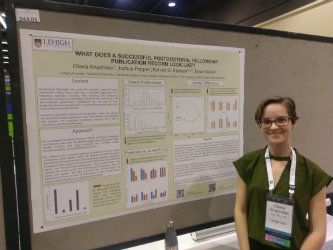Through an independent research project with Oliwia Krupinska ’20, Pepper, an associate professor in the department of physics, finally got an answer—there is no set standard, at least when it comes to NASA prize postdoctoral fellowships.
Pepper presented Krupinska, who did the heavy lifting, with the idea for the project. “He said it’s not going to be directly astrophysics, which is what he mostly does,” Krupinska says. “He said it would be bibliometrics. For a second, I was hesitant because I was hoping to do something more elaborate, but ... he explained to me the whole point of it is, we’re going to look, actually, at how the application processes work with these postdoctoral fellowships.”
Knowing how anxious students get thinking about the minimum standards for college, and as someone considering graduate school, Krupinska was eager to help find answers. Pepper had Krupinska look at NASA prize postdoctoral fellowships, with research limited to instances where highly sought individuals were working for themselves.
Krupinska gathered four years of data, from 2014 to 2017, to find 133 recipients of positions during that timespan. With three different categories of awards, Krupinska had to look up each one separately for each year, collecting names, graduation years and award years. Then Krupinska searched NASA’s database to find the number of publications each person had. Some names were listed multiple times and overlapped timespans. In those cases, Krupinska heavily relied on the CVs [curricula vitae] to extract data.
Krupinska also tracked “first author” and “other.” Pepper says in this field, the publication is primarily the work of the first author listed.
“There’s actually a pretty broad, diverse pattern when it comes to publication for the people who actually get these fellowships,” Pepper says.
Many people with postdoctoral positions had first-authored five or six papers and co-authored 10 to 15. But several had only one or two first-authored papers and two or three total publications. The key finding is that there is no absolute threshold for number of papers that applicants need to get postdocs. Although publications are one of the few elements of an applicant’s portfolio that are public and can be quantified, they are not a good predictor of success. Other elements of a postdoc application, including recommendation letters, leadership in the field and proposed research projects, are likely equally important, if not more so.
“This project is a way of evening the information asymmetry, giving the applicants a little more information about what things actually look like,” Pepper says.
This was only the second time in 16 years that Pepper published a paper with an undergraduate who conducted the majority of the work. He also says it’s by far the shortest amount of time spent from start of research to paper.
“This happened to be a project that was well defined, and Oliwia did an amazing job on this and got a lot of this done very quickly, so that by the end of the semester, we nearly were at a point where we could submit a paper,” Pepper says.
Publications of the Astronomical Society of the Pacific published Krupinska’s paper “What Does a Successful Postdoctoral Fellowship Publication Record Look Like?” in January, the same month Krupinska presented at the National Meeting of the American Astronomical Society in Seattle.






